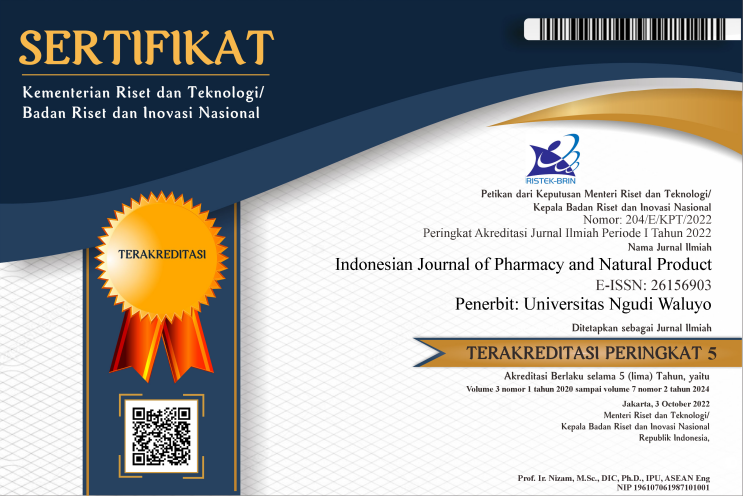Tingkat Pengetahuan, Sikap Merokok dan Nicotine Gum Therapy pada Mahasiswa Universitas Kristen Satya Wacana
DOI:
https://doi.org/10.35473/ijpnp.v5i2.1892Keywords:
Pengetahuan, sikap, merokok, nicotine gum therapyAbstract
Cigarettes are cylinders made of paper containing chopped tobacco leaves. Nicotine Replacement Therapy is a therapy used to help smokers to quit smoking. The purpose of the study was to examine the level of knowledge, smoking attitudes and nicotine gum therapy in Satya Wacana Christian University students. The research method used is a non-experimental quantitative method using analytical descriptive methods. Respondents in the study were Satya Wacana Christian University Psychology Study Program students semester III, VI and IX totaling 67 students. Prospective data collection. The results of this study were the results of the validity test of the questionnaire on the level of knowledge, smoking attitudes and nicotine gum therapy on Satya Wacana Christian University students. Stating that all question variables are valid. Based on the reliability test of the questionnaire, the level of knowledge, smoking attitude and nicotine gum therapy obtained a value of > 0.60 which means that the questionnaire is reliable. The level of knowledge of smoking and nicotine gum therapy was found to be 71.84% with a fairly good level of knowledge category, the level of smoking attitude and nicotine gum therapy obtained results of 51.84% with a category of poor attitude level.The level of knowledge of smoking and nicotine gum therapy was found to be 71.84% with a fairly good level of knowledge category, the level of smoking attitude and nicotine gum therapy obtained results of 51.84% with a category of poor attitude level.
ABSTRAK
Rokok merupakan silinder yang terbuat dari kertas berisi daun tembakau yang telah dicacah. Nicotine Replacement Therapy adalah terapi yang digunakan untuk membantu perokok untuk berhenti merokok. Tujuan penelitian untuk menganalisis tingkat pengetahuan, sikap merokok dan nicotine gum therapy pada mahasiswa Universitas Kristen Satya Wacana. Metode penelitian yang digunakan adalah metode kuantitatif non eksperimental menggunakan metode deskriptif analitik. Responden pada penelitian yaitu mahasiswa Universitas Kristen Satya Wacana Prodi Psikologi semester III, VI dan IX berjumlah 67 mahasiswa. Pengambilan data secara prospektif. Hasil penelitian ini adalah uji validitas kuesioner tingkat pengetahuan, sikap merokok dan nicotine gum therapy pada mahasiswa Universitas Kristen Satya Wacana menyatakan bahwa semua variabel pertanyaan valid. Berdasarkan uji reliabilitas kuesioner tingkat pengetahuan, sikap merokok dan nicotine gum therapy memperoleh nilai >0,60 yang menyatakan bahwa kuesioner tersebut reliabel. Tingkat pengetahuan merokok dan nicotine gum therapy didapatkan hasil 71,84% dengan kategori tingkat pengetahuan cukup baik, tingkat sikap merokok dan nicotine gum therapy memperoleh hasil sebesar 51,84% dengan kategori tingkat sikap kurang baik.Tingkat pengetahuan merokok dan nicotine gum therapyyaitu 71,84% dengan kategori tingkat pengetahuan cukup baik, Tingkat Sikap merokok dan nicotine gum therapyyaitu sebesar 51,84% dengan kategori tingkat sikap kurang baik.
References
Adam, T. 2006. Investigation of tobacco pyrolysis gases and puff-by-puff resolved cigarette smoked by single photonionization (SPI)- time-of-flight mass spectrometry (TOFMS). Disertasi Technischen Universitas, Munchen.
Anonim. 2013. 1000 Tanaman Khasiat dan Manfaatnya. www.indonews.co.id. Diakses tahun 2022
Aspuah, S. (2013). Kumpulan Kuesioner dan Gudang Instrumen Penelitian Kesehatan. Nuha Medika.
Aula, Lisa Ellizabet. 2010. Stop Merokok (Sekarang atau Tidak Sama Sekali!). Yogyakarta: CV. Garailmu.
Benowitz etal, (2009). Nicotine Chemistry, Metabolism, Kinetics and Biomarkers. Handb Exp Pharmacol. 2009; (192) , 29-60.
Bustan. (2017). Epidemiologi Penyakit Tidak Menular. Jakarta: PT Rineka Cipta.
Etter, J. F., & Stapleton, J. A. (2016). Nicotine Replacement Therapy for long-term smoking cessation: a meta analysis. Tobacco Control, 15(4), 280-285
Fiore, Bailey dan Chohen, J. A. (2016). Smoking Cessation. Clin Pract. Guideline, 1(1), 1-12. Retrieved from www.ahcpr.gov/clinic/smoview.htm
George TP. Nicotineandtobacco. In: Goldman L, Schafer AI, eds. GoldmanCecilMedicine. 26th ed. Philadelphia, PA: Elsevier; 2020:chap 29.
Gondodiputro, S. 2007. Bahaya Tembakau dan Bentuk-Bentuk Sediaan Tembakau. Fakultas Kedokteran Universitas Padjadjaran. Bandung
Heryani. (2014). Kumpulan Undang-Undang Dan Pemerintah republik Indonesia Khusus Kesehatan. Jakarta : CV . Trans Info Media.
Ilett KF, Hale TW, Page-Sharp M, etal. Use of nicotine patches in breast-feedingmothers: Transfer of nicotine and cotininein to human milk. Clin Pharmacol Ther. 2003;74:516–24
Kemenkes RI. 2015. Infodatin: Perilaku Merokok Masyarakat Indonesia. (http://www.depkes.go.id/resources/download/pusdatin/infodatin/infodatinhari-tanpa tembakau-sedunia.pdf, diakses tahun 2022)
Lactmedwebsite http://toxnet.nlm.nih.gov/cgibin/sis/htmlgen?LACT
Leventhal, Howard & Cleary, Paul D. (2003). The Smoking Problem: A Review of the Research and Theory in Behavioral Risk Modification. Psychological Bulletin, 80(2): 370-405.
Lindsey F Stead, Rafael Perera, Chris Bullen, David Mant, Jamie Hartmann-Boyce, Kate Cahill, Tim Lancaster. Terapi Pengganti Nikotin untuk berhenti merokok (Perpustakaan Cochrane)
Lizam, C.T. (2009). Meningkatkan sikap positif terhadap perilaku tidak merokok dan kecenderungan untuk berhenti merokok melalui pelatihan kecerdasan emosional pada mahasiswa SMA di Kabupaten Aceh Barat Daya – Nanggroe Aceh Darussalam. Tesis. Universitas Gadjah Mada, Yogyakarta
Marks, Murray, etal. 2004. Health Psychology :Theory, Research & Practice. Sage Publishing: London.
Masturoh, I., & T, N. A. (2018). Metodologi Penelitian Kesehatan. In Bahan Ajaran Rekam Medis dan Informasi Kesehatan (RMIK). Pusat Pendidikan Sumber Daya Manusia Kesehatan Badan Pengembangan dan Pemberdayaan Sumber Daya Manusia Kesehatan, Kementrian Kesehatan Indonesia.
Mu’tadin, Z. (2008). Pengantar Pendidikan dan Ilmu Perilaku Kesehatan. Yogyakarta: Andi Offset.
Notoatmodjo, S. (2010). Metodologi Penelitian Kesehatan. Rineka Cipta.
Notoatmodjo, S. (2012). Promosi Kesehatan dan Ilmu Perilaku. Rineka Cipta.
Notoatmodjo, S. (2014). Ilmu Perilaku Kesehatan. Rineka Cipta.
Peraturan Pemerintah Republik Indonesia Nomor 109 Tentang Pengamanan Bahan yang mengandung Zat Adiktif Berupa Produk Tembakau Bagi Kesehatan. (2012).
Prasetya Lukita. (2016). Pengaruh Negatif Rokok bagi Kesehatan di Kalangan Remaja
Proverawati dan Rahmawati, P. (2012). Perilaku Hidup Bersih dan Sehat. Jakarta: Mulia Medika.
Reginald V. Fant, Jack E. Henningfield. Terapi Pengganti Nikotin. Perawatan primer: klinik di kantor praktek 2009; 26:633–652
Riskesdas. 2018. Riset Kesehatan Dasar. Diakses pada 2022
Rodgman, A. and T.A. Perfetti. 2006. The composition of cigarette smoke; A catalogue ot the polycyclic hydrocarbons. Beiträgezur Tabak for chung 22(1):13-69.
Russell MA, Feyerabend C, Cole PV. Kadar nikotin plasma setelah merokok dan mengunyah permen karet nikotin. Jurnal Medis Inggris 1976; 1:1043–6.
Saragi, E. Y. (2018). Gambaran Pengetahuan Sikap dan Tindakan. In Energies (Vol. 6, Issue 1).
Schatz, B. S. (2008). Nicotine Replacement Products: Implications for the Breastfeeding Mother., 161-163.
Setyoadi, F. (2011). Indonesia menempati urutan pertama dalam jumlah perokok remaja.
Silagy C, Lancaster T, Stead L, Mant D, Flower G. Terapi penggantian nikotin untuk berhenti merokok. CochraneDatabaseSystRev. 2004;3:CD000146.
Sugiyono. (2017). Metode Penelitian Kuantitatif dan Kualitatif dan R&D. Alfabeta Bandung.
Sukmana, Teddie. 2011. Mengenal Rokok dan Bahayanya. Jakarta
Tore Sanner, Tom K. Grimsrud Karsinogenisitas nikotin dan efeknya terhadap respons terhadap pengobatan/ulasan kanker. Onkol depan. 2015; 5: 196-197
Tri Basuki, Agus. (2017). Ekonometrika dan Aplikasi dalam Ekonomi. Universitas Muhammadyah Yogyakarta. PT. Danisa Media
WHO, 2017(a). FactSheets: Tabacco. (http://www.int/mediacentre/factsheets /fs339/en/ diakses 2022)




